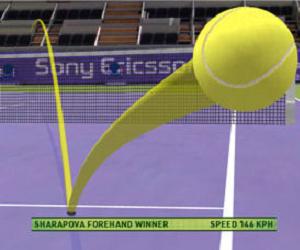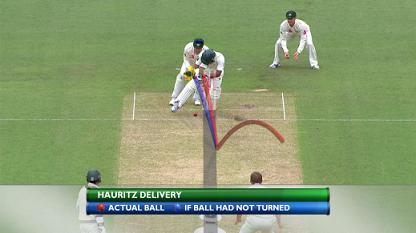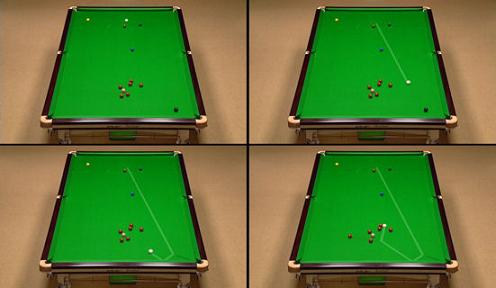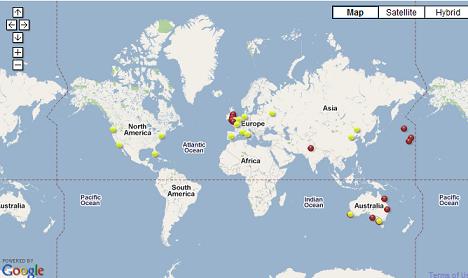Hawk-Eye Augments Referees With Computers – Professional Sports are Evolving
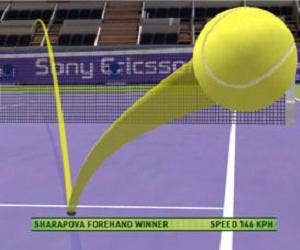
Share
The same video camera technology that calls tennis shots in professional tournaments could be on its way to judging goals in soccer matches. Arguments at the pub may never be the same again. Hawk-Eye, developed in the UK, uses an array of video cameras carefully arranged in a sports arena to capture images of a ball as it travels. With special analytical software, Hawk-Eye is able to transform the 2D videos into a 3D rendering that allows you to know the ball's position on the field exactly. In or out of bounds? Hawk-Eye answers the question once and for all. FIFA and other soccer institutions are testing Hawk-Eye and similar technologies to determine if/when a ball travels past the goal line. This is just the latest conquest for the system. Hawk-Eye has been used in cricket for the better part of the last decade, it's been a fixture of professional tennis for more than five years, and the technology is seeing use in Snooker now as well. With benefits to players, referees, and coaches, Hawk-Eye's video analysis is likely to continue spreading. Watch the technology in action in the videos and pictures below. The mounting invasion of Hawk-Eye into stadiums around the world is another sign that computers have become an inescapable part of professional sports.
Here's a quick look at the 3D rendering that Hawk-Eye produces for tennis matches. This animation is actually the end-product of the system. Computers have taken images from 10 different cameras (in most setups) and pieced them together to form the following composite. It's a bit fancier than the two eyes most judges have, but much more accurate as well:
Part of getting tennis fans to accept the technology has been transparency in how the system works. Here's a reporter for the Sony Ericsson WTA Tour taking a look in the Hawk-Eye control room. This is a brief clip, but it should give you a better idea of how the technology works:
Part of the push for the adoption of Hawk-Eye arose after several contentious calls at the 2004 US Open during a match between Serena Williams and Jennifer Capriati. Soccer has it's own rallying event for the adoption of goal-line technology: the famous 'no-goal' shot by Frank Lampard during the UK-Germany match of the 2010 World Cup. Human judges missed what traditional TV cameras clearly showed was a goal.
Officially, FIFA is still only considering goal-line technologies. Tests in February (which did not include Hawk-Eye) failed to demonstrate a system that could be successful 100% of the time. Yet Hawk-Eye Innovation, the company behind the invention, believe that when allowed to properly set up equipment in a soccer arena, their video analysis will prove flawless. Ireland footballers will try the technology out soon, and Australia has expressed interests in pioneering use of the technology for their league(s). With all due respect to soccer/football fans who deny that any such tech will ever find a home in their sport, all signs point to the eventual adoption of Hawk-Eye or some other goal-line tech.
Be Part of the Future
Sign up to receive top stories about groundbreaking technologies and visionary thinkers from SingularityHub.


It's about time. If you look at the way in which Hawk-Eye is used in cricket and tennis, you see that the application has largely been accepted by players and fans (with notable exceptions). With a trustworthy technology providing a definitive call in matches, tennis and cricket can focus on what's most important: the sport itself.
Yet there are benefits to Hawk-Eye that extend far beyond settling contentious calls by referees, line judges and the like. Hawk-Eye records the placement and angle of all the shots made in a match. This allows color commentators to discuss how a player is performing, and tennis tournaments have had great success selling sponsorship for Hawk-Eye as an additional source of revenue. More importantly visual analysis records give coaches another tool in advising their athletes, and players have a better idea of their competitors habits. In essence, Hawk-Eye not only removes contention and allows us to focus on the game, it adds another level to the game.
The field of advanced sports analysis is still blossoming, but already Hawk-Eye has major competition. Cairos has a goal-line technology for soccer that would rely on magnetic fields, embedded sensors, and relay antennas. Animation Research LTD's technology, Virtual Eye uses visual tracking and is already in use in cricket matches. If Hawk-Eye should prove to have a fatal flaw, of it Hawk-Eye Innovations fails as a business, we can still expect the new industry of athletic analysis to thrive.
Of course, Hawk-Eye and its generation of new analytical companies are just the latest incarnation of a trend that has been building for some time. Photo finishes are a staple in racing. Video instant replay has been used in sports for years, often with official status (as in the NFL). Professional fencing is heavily reliant upon electronic sensors, as is the judging of many Olympic events. Every new technology finds a place in sports, and sports adapt themselves to the new developments. In the future, computers are going to increase their presence, and in ways that shape not only how the game is performed, but how we view that performance. We've seen tracking technologies that will allow computers to automatically decide which TV cameras are showing the best coverage of a basketball game, and to switch between them accordingly. There are a growing number of automated journalists, artificial intelligence programs that take sports statistics and generate completely original articles for fans to read. At every level, computers are becoming a more powerful factor in athletics. For now, that simply means fans, players, and officials will get a more nuanced experience to enjoy. Eventually, soccer fans may have to face the possibility that not only will computers take the roles of referees, they may replace the players as well.
[image credits: Hawk-Eye Innovations]
[video credits: Hawk-Eye Innovations via gamefanslovenia, Sony Ericsson WTA Tour]
[sources: Hawk-Eye]
Related Articles

Hugging Face Says AI Models With Reasoning Use 30x More Energy on Average

Study: AI Chatbots Choose Friends Just Like Humans Do

AI Companies Are Betting Billions on AI Scaling Laws. Will Their Wager Pay Off?
What we’re reading
